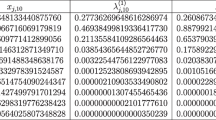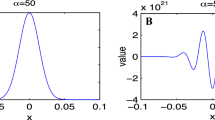Abstract
This paper synthesizes formally orthogonal polynomials, Gaussian quadrature in the complex plane and the bi-conjugate gradient method together with an application. Classical Gaussian quadrature approximates an integral over (a region of) the real line. We present an extension of Gaussian quadrature over an arc in the complex plane, which we call complex Gaussian quadrature. Since there has not been any particular interest in the numerical evaluation of integrals over the long history of complex function theory, complex Gaussian quadrature is in need of motivation. Gaussian quadrature in the complex plane yields approximations of certain sums connected with the bi-conjugate gradient method. The scattering amplitude c T A −1 b is an example where A is a discretization of a differential–integral operator corresponding to the scattering problem and b and c are given vectors. The usual method to estimate this is to use c T x (k). A result of Warnick is that this is identically equal to the complex Gaussian quadrature estimate of 1/λ. Complex Gaussian quadrature thereby replaces this particular inner product in the estimate of the scattering amplitude.
Similar content being viewed by others
References
D. Arnett, Supernovae and Nucleosynthesis (Princeton Univ. Press, Princeton, 1996).
S.F. Ashby, T.A. Manteuffel and P.E. Saylor, A taxonomy for conjugate gradient methods, SIAM J. Numer. Anal. 27(6) (1990) 1542–1568.
O. Axelsson, Iterative Solution Methods (Cambridge Univ. Press, Cambridge, 1996).
T.L. Barth and T.A. Manteuffel, Conjugate gradient algorithms using multiple recursions, in: Linear and Nonlinear Conjugate Gradient Related Methods, eds. L. Adams and J.L. Nazareth (SIAM, Philadelphia, PA 1996).
W.E. Boyse, D.R. Lynch, K.D. Paulsen and G.N. Minerbo, Nodal based finite element modeling of Maxwell's equations in three dimensions, IEEE Trans. Antennas and Propagation 40(6) (1992) 642–651.
W.E. Boyse, D.R. Lynch, K.D. Paulsen and G.N. Minerbo, Scalar and vector potential formulation for finite element solutions to Maxwell's equations, in: Proc. IEEE AP–S International Symposium, Vol. 1 (Springer, Berlin, 1992) pp. 516–519.
W.E. Boyse, G.N. Minerbo, K.D. Paulsen and D.R. Lynch, Applications of potentials to finite element modeling of Maxwell's equations, IEEE Trans. Magn. 29 (1993) 1333–1336.
C. Brezinski, Padé-Type Approximation and General Orthogonal Polynomials (Birkhäuser, Basel, 1980).
C. Brezinski, Biorthogonality and Its Applications to Numerical Analysis (Marcel Dekker, New York, 1992).
D. Calvetti, G.H. Golub and L. Reichel, An adaptive Chebyshev iterative method for nonsymmetric linear systems based on modified moments, Numer. Math. 67 (1994) 21–40.
W.C. Chew, Waves and Fields in Inhomogeneous Media (Oxford, New York, 1996).
G. Dahlquist and Å. Björck, Numerical Methods (Prentice-Hall, Englewood Cliffs, NJ, 1974).
G. Dahlquist, S.C. Eisenstat and G.H. Golub, Bounds for the error of linear systems of equations using the theory of moments, J. Math. Anal. Appl. 37 (1972) 151–166.
G. Dahlquist, G.H. Golub and S. Nash, Bounds for the error in linear systems, in: Proc. of the Workshop on Semi-Infinite Programming, ed. R. Hettich (Springer, New York) pp. 154–172.
T.A. Driscoll, K.-C. Toh and L.N. Trefethen, From potential theory to matrix iterations in six steps, SIAM Rev. 40 (1998) 547–581.
B. Fischer and G.H. Golub, On the error computation for polynomial based iteration methods, in: Recent Advances in Iterative Methods (Springer, New York, 1993) pp. 59–69.
R. Freund, M. Gutknecht and N.M. Nachtigal, An implementation of the look-ahead Lanczos algorithm for non-Hermitian matrices, SIAM J. Sci. Statist. Comput. 14 (1993) 137–158.
R.W. Freund, The look-ahead lanczos process for large nonsymmetric matrices and related algorithms, in: Linear Algebra for Large Scale and Real Time Applications (Kluwer Academic, Dordrecht, 1993) pp. 137–163.
R.W. Freund and M. Hochbruck, Gauss quadrature associated with the Arnoldi process and the Lanczos algorithm, in: Linear Algebra for Large Scale and Real Time Applications (Kluwer Academic, Dordrecht, 1993) pp. 377–380.
W. Gander and J. Hřebíček, Solving Problems in Scientific Computing using Maple and Matlab (Springer, Berlin, 1995).
W. Gautschi, Orthogonal Polynomials: Applications and Computation, Vol. 5 (Cambridge Univ. Press, Cambridge, 1996) pp. 45–119.
W. Gautschi, Numerical Analysis: An Introduction (Birkhäuser, Boston, 1997).
G.H. Golub, Some modified matrix eigenvalue problems, SIAM Rev. 15(2) (1973) 318–334.
G.H. Golub, Private communication, 1996.
G.H. Golub and G. Meurant, Matrices, moments and quadrature, in: Numerical Analysis 1993: Proc. of the 15th Dundee Conference, June–July 1993, eds. D.F. Griffiths and G.A. Watson, Essex, England, Pitman Research Notes in Mathematics Series, Vol. 303 (Longman, Harlow, 1994) pp. 105–156.
G.H. Golub and G. Meurant, Matrices, moments and quadrature II or how to compute the norm of the error in iterative methods, BIT 37(3) (1997) 687–705.
G.H. Golub and C.F. Van Loan, Matrix Computations, 3rd edn. (Johns Hopkins Univ. Press, Baltimore, MD, 1996).
G.H. Golub and J.H. Welsch, Calculation of Gauss quadrature rules, Math. Comp. 23 (1969) 221–230.
R.G. Gordon, Error bounds in equilibrium statistical mechanics, J. Math. Phys. 9(5) (1967) 655–663.
R.G. Gordon, Error bounds in spectroscopy and nonequilibrium statistical mechanics, J. Math. Phys. 9(7) (1967) 1087–1092.
W.B. Gragg, Positive definite Toeplitz matrices, the Arnoldi process for isometric operators, and gaussian quadrature on the unit circle, J. Comput. Appl. Math. 46 (1993) 183–198; English transl. of 1982 Russian article.
M. Gutknecht, Lanczos Type Solvers for Nonsymmetric Linear Systems of Equations (Cambridge Univ. Press, Cambridge, 1997) pp. 271–398.
M.T. Heath, Scientific Computing: An Introductory Survey (McGraw-Hill, New York, 1997).
P. Henrici, Applied and Computational Complex Analysis, Vol. 2 (Wiley, New York, 1977).
M.R. Hestenes and E. Stiefel, Methods of conjugate gradients for solving linear systems, J. Res. of NBS 49 (1952) 409–435.
C.T. Kelley, Iterative Methods for Linear and Nonlinear Equations, SIAM Frontiers Series, Vol. 16 (SIAM, Philadelphia, PA, 1995).
L.D. Landau and E.M. Lifshitz, Quantum Mechanics (Non-relativistic Theory), 3rd edn. (Pergamon, Oxford, 1977).
L. Lempert, Recursion for orthogonal polynomials on complex domains, Colloq. Math. Soc. János Bolyai 19 (1976) 481–494.
F.E. Low, Classical Field Theory, Electromagnetism and Gravitation (Wiley, New York, 1998).
G.N. Minerbo, G.H. Golub and P.E. Saylor, Nine ways to solve a scattering problem I, Technical Report, Stanford University (2001), in preparation.
R.G. Newton, Scattering Theory of Waves and Particles, 2nd edn. (Springer, New York, 1982).
K.D. Paulsen, Finite element solution of Maxwell's equations with Helmholtz forms, Optical Society of America A: Special Issue on Scattering by Three-dimensional Objects 11 (1994) 1434–1444.
N.A. Pierce and M.B. Giles, Adjoint recovery of superconvergent functionals from pde approximations, SIREV 42(2) (2000) 247–264.
Y. Saad, Iterative Methods for Sparse Linear Systems (PWS, Boston, 1996).
H.S. Shapiro, The Schwarz Function and Its Generalization to Higher Dimensions (Wiley, New York, 1992).
D.C. Smolarski, Optimum semi-iterative methods of the solution of any linear algebraic system with a square matrix, Ph.D. thesis, Department of Computer Science, University of Illinois, Urbana (December 1981). Available as Technical Report 1077.
E. Stiefel, Kernel polynomials in linear algebra and their numerical applications, Nat. Bureau Standards Math. Ser. 49 (1958) 1–22.
G. Szegő, Orthogonal Polynomials, 4th edn. (Amer. Math. Soc., Providence, RI, 1975).
K.F. Warnick, Private communication (1998).
K.F. Warnick, Continued fraction error bound for conjugate gradient method, Technical Report ECEN Department Report No. TR-L100-98.3, Department of Electrical and Computer Engineering, Brigham Young University, Provo, UT 84602 (9 June 1997).
K.F. Warnick, Gaussian quadrature and scattering amplitude (exact title tbd), Technical Report No. TBD, Department of Electrical and Computer Engineering, Center for Computational Electromagnetics, University of Illinois, Urbana–Champaign (2000).
H.S. Wilf, Mathematics for the Physical Sciences (Wiley, New York, 1962).
Author information
Authors and Affiliations
Rights and permissions
About this article
Cite this article
Saylor, P.E., Smolarski, D.C. Why Gaussian quadrature in the complex plane?. Numerical Algorithms 26, 251–280 (2001). https://doi.org/10.1023/A:1016612909180
Issue Date:
DOI: https://doi.org/10.1023/A:1016612909180




